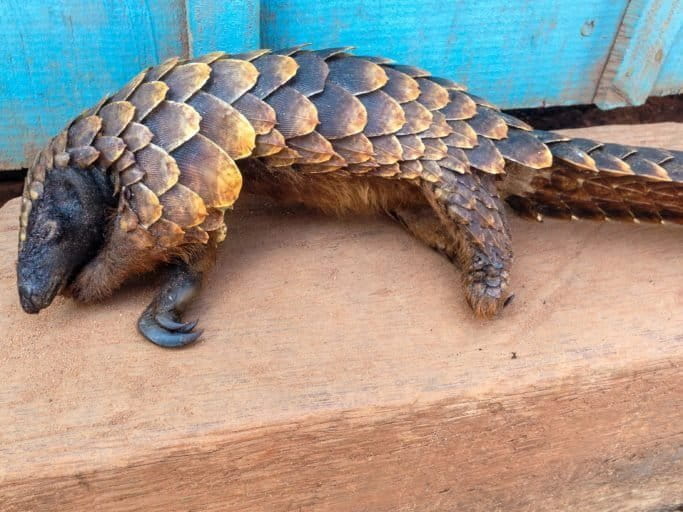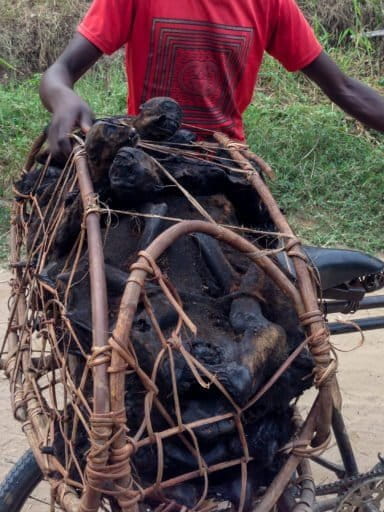- A study pulling together information on threatened land mammals found that hunting for meat and medicine is driving 301 toward extinction.
- The authors raise concerns about food security for humans and ecosystem collapse if we don’t prevent this crisis for mammals.
- Proposed solutions include shoring up international markets for bushmeat and animal body parts, investments in laws and enforcement to protect wildlife, and increased education about the scale of the problem.
It’s no secret that many mammals face a dire future, as we humans hunt them to satisfy our desire for protein, medicines and animal parts. But until now, scientists have had little idea about how many species we’re endangering.
“I had an inkling that there’s a significant problem,” said William Ripple, an ecologist at Oregon State University. He and many of his colleagues in the field have seen study after study reporting drops in local populations of land mammals due to hunting.
“So we thought it would help to go ahead and put some actual numbers and species names to it and analyze it on a global scale,” Ripple said.

In all, they pinpointed hunting for food or medicines as the most significant threat to more than 300 species of mammals, including 126 primates.
“I was surprised and shocked to see the breadth of the problem,” Ripple said in an interview with Mongabay. “It works across all faunal groups, especially the ones that have higher body masses.”
In research published on October 18 in the journal Royal Society Open Science, Ripple and his colleagues compiled data from published research on mammals listed as threatened on IUCN’s database – that is, those in categories ranging from “Least Concern” to “Critically Endangered.” In addition to the 301 mammals that are in the most danger from hunting for consumption, Ripple said he figures another 200 or so are also being chased toward extinction, but whether hunting – as opposed to habitat loss or climate change, for example – is the main driver wasn’t clear.
What’s remarkable about the team’s research is that these numbers don’t include some of the more famous animals facing crises of their own – elephants, for example – that aren’t hunted much for meat or medicine. Instead, their analysis highlights lesser-known mammals that may be slipping toward extinction without our knowledge — among them, Asia’s Bactrian camel, 27 species of bats and all eight species of pangolins, scaly inhabitants of Asia and Africa that resemble anteaters.

“One of our major goals in publishing this paper is to increase awareness of the magnitude of the issues here,” Ripple said.
And it’s not simply the loss of another species that’s at risk, Ripple said. He and his colleagues point out that millions of people, mostly in Africa, Southeast Asia and South America, depend on dwindling populations of mammal species to feed themselves and their families. Only about two percent of hunted mammal populations are actually holding steady or growing.
At the same time, mammals are often of vital importance to the ecosystems in which they live. Many are important vehicles for scattering seeds throughout their habitat, for example.
The detrimental impact hunting has on mammals is a complex problem with myriad causes, ranging from poor governance, ballooning human populations and a lack of understanding of the situation, write the paper’s authors.

“If these animals are to be saved, there needs to be a much stronger awareness by humans,” Ripple said.
Still, “I am hopeful that we can find solutions to this global crisis on the overexploitation of the wildlife,” he added.
He said that better enforcement of hunting laws has had a proven effect on wildlife populations, and that we as a species need to look for alternative, less environmental costly food sources, such as protein-rich plants or insects.
Ripple also pointed out that while bushmeat hunting takes place almost exclusively in the developing world, the demand for the resulting products often comes from more prosperous countries. He cited the huge demand for wildlife products and food in Asia, as well as a study that found that 260 tons of bushmeat was “smuggled” in 2008 through Charles de Gaulle airport in Paris, an important European gateway to the African continent.

“If the commercial international trade in wildlife meat and body parts was curtailed, that would help a lot,” he said.
Ripple noted that getting the word out about the scale of this problem was only the first step. Once people understand what’s at stake, whether they live in a New York City high rise or an elevated house along the Amazon River, he said he is confident that we’re capable of stopping this trend.
“The vast majority of people have a strong affection for wildlife species, he said. “That is in our favor for getting some conservation going, rather than letting large numbers of species go extinct.”
Citations:
- Chaber A.-L. et al. (2010). The scale of illegal meat importation from Africa to Europe via Paris. Conservation Letters.
- Hilborn R. et al. (2006). Effective enforcement in a conservation area. Science.
- Ripple W. J. et al. (2016). Bushmeat hunting and extinction risk to the world’s mammals Royal Society Open Science.
- Rosin, C. and Poulsen, J. R. (2016). Hunting-induced defaunation drives increased seed predation and decreased seedling establishment of commercially important tree species in an Afrotropical forest. Forest Ecology and Management.














